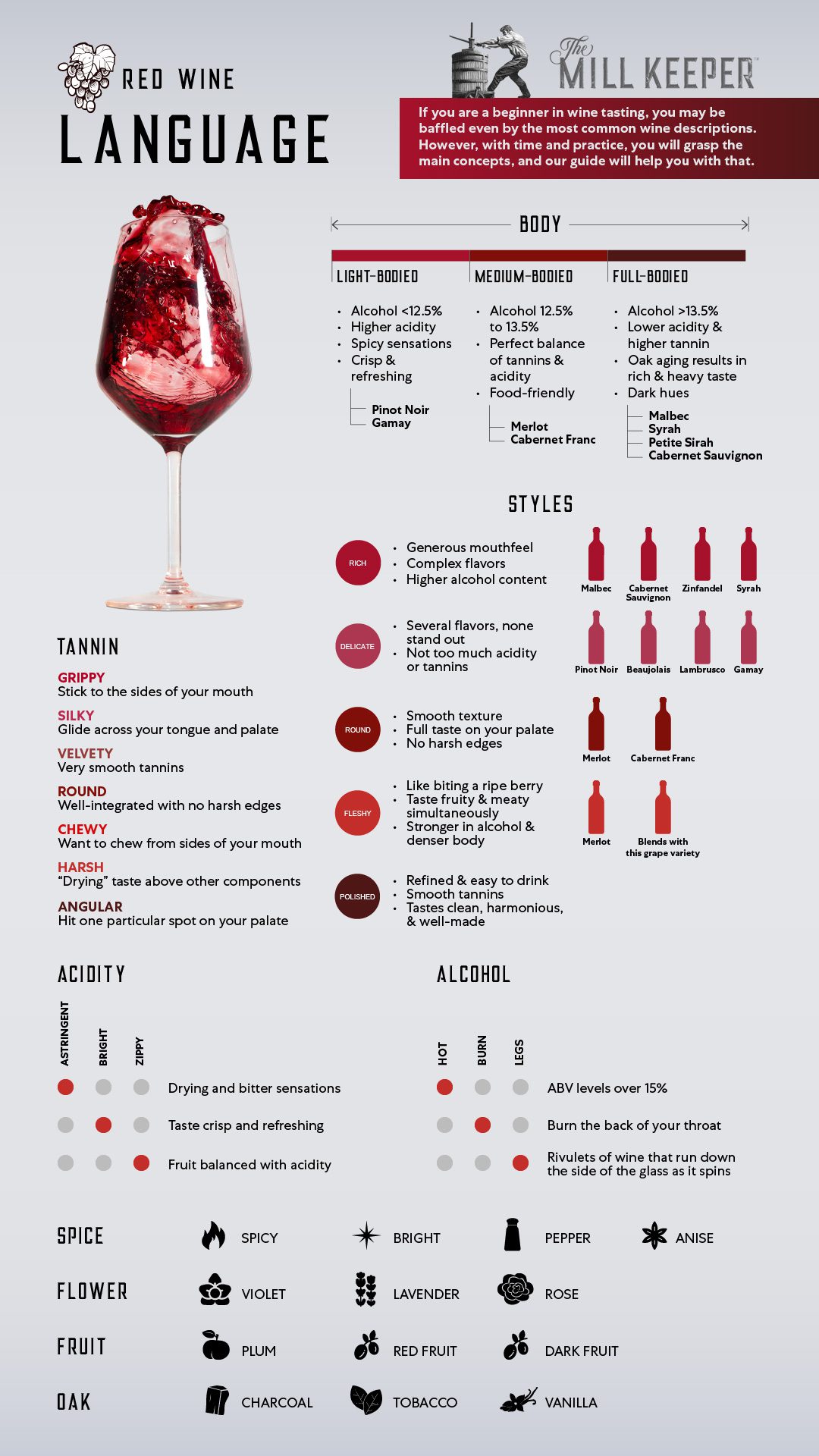The red wine descriptions chart explained to beginners [Infographic]
Have you ever seen those charts and tables giving descriptions of red wine? They contain descriptions of the body, style, tannin, acidity, and many more. As wine description charts are full of unfamiliar wine-tasting terms, you might need clarification as an amateur wine connoisseur.
To help you shed some light on the language spoken by wine experts, we will cover common wine descriptions used in charts. Once familiar with them, you can translate your preferences into the wine language. The terms from the wine descriptions chart may also come in handy when choosing wine for different occasions and talking to wine pros at a wine store.

How can a wine chart help me when choosing wine?
Choosing wine can be a challenging yet exciting process. Many aspects of wine affect its density, color, alcohol degree, taste, and smell. The most reliable way to understand your desires and preferences is, of course, tasting. But why waste money on numerous bottles of wine that you may not even like? A better idea is to look at the chart and see which wine will likely be your perfect match!
Let’s talk about familiar and less evident aspects of red wine to help you get more confident with charts and, thus, wine types.
Body
Wine body means its weight on the palate, also called viscosity. Several components make up the wine body. First and foremost, it’s the alcohol content that gives the drink in your glass viscosity. Other factors are the grape variety, the climate the grapes have grown in, oak aging, and residual grape sugars.
Based on the body, wines can be light, medium, and full-bodied.
Light-bodied
Light-bodied wines typically have an alcohol percentage below 12.5%. They also have higher acidity displayed in sharp and sometimes spicy sensations in your mouth.
Light wine varieties are crisp and refreshing and make perfect pairings with light dishes like seasonal salads, fresh fruit, and seafood.
Light-bodied white wines include Pinot Grigio, Riesling, and Sauvignon Blanc. Light-bodied wine varieties among reds are Pinot Noir and Gamay.
Medium-bodied
Next come medium-bodied varieties with alcohol percentages between 12.5% and 13.5%. A perfect balance of tannins and acidity makes these wines very food-friendly.
Medium-bodied red wines worth trying are Merlot and Cabernet Franc.
Full-bodied
Full-bodied wines taste rich and heavy because of a higher alcohol percentage (above 13.5%), lower acidity, and higher tannin. Oak aging can also contribute to the rich taste of these wines by adding vanilla or cedar flavors.
Dark hues like burgundy, opaque purple, or deep purple are typical for full-bodied red wines.
Notable full-bodied reds are Malbec, Syrah, Petite Sirah, and Cabernet Sauvignon are outstanding full-bodied reds. As for rich white wines, CA Chardonnay is a great example.
Check out this infographic to get a visual overview of various wine styles:

Style
Style is a larger spectrum by which we see wine. For example, style may include body, tannin, acidity, alcohol, flavor, and aroma. Let’s look through several terms used to describe different wine styles.
Rich
If you feel intense and pleasant flavors like fruitiness or vanilla notes in the wine you are sipping, it’s a rich wine in front of you. The term “rich” commonly applies to full-bodied wines with generous mouthfeel, complex flavors, and higher alcohol content.
Malbec, Cabernet Sauvignon, Zinfandel, and Syrah are all rich reds.
Delicate
The term “delicate,” in turn, commonly applies to wines that are lighter in their body — light and medium-bodied ones. While delicate wines may have several flavors, none stand out. You won’t feel too much acidity or tannins when sipping a soft wine.
Examples of delicate reds are Pinot Noir, Beaujolais, Lambrusco, Gamay, and Grenache, with Lambrusco being the lightest red.
Round
Wines described as round typically have a smooth texture. They taste full on your palate, with no harsh edges. Merlot and Cabernet Franc are great wines in the round red wines category.
Fleshy
When sipping a wine feels like biting into a ripe berry or fruit, it’s safe to call such a wine “fleshy.” Sometimes, fleshy wines can taste fruity and meaty simultaneously. In addition, these wines are typically stronger in alcohol and denser in their body.
Fleshiness is common for Merlot and blended wines made with this grape variety.
Polished
“Polished” is a term used to describe a wine that is refined and easy to drink. Thanks to smooth tannins, it tastes clean, harmonious, and well-made.
Tannin
Tannins are a group of phenolic compounds found in grape skins, seeds, and stems. They get into the wine in the process of maceration and aging in oak barrels. Tannins give the wine structure as one of the four main parameters for evaluating a wine, along with acidity, body, and alcohol level.
The level of tannins differs across wines depending on the grape variety and wine-making techniques. In red wines, tannins are a priori most noticeable. Thick and dark-skinned grapes like Cabernet Sauvignon (the most planted grape in the world) and Syrah typically produce the most tannic wines. Conversely, thin-skinned varieties like Pinot Noir or Grenache are not that rich in tannins.
Let’s see how experienced wine drinkers describe tannins.
Grippy
When you hear that the tannins in this wine are grippy, they are immediately noticeable, sticking to the sides of your mouth.
Silky
The term “silky” describes tannins perfectly built into the wine structure. As wine lovers say, silky tannins glide across your tongue and palate.

Photo by Jonathan Farber on Unsplash
Velvety
When you hear of a velvety wine, this description refers to the character of tannins. Soft tannins are very smooth. Compared to silky tannins, velvety ones are a bit more noticeable.
Round
Want more terms for smooth tannins? “Round” is another one that describes well-integrated ripe tannins with no bite or harsh edges.
Chewy
Chewing tannins are so intense that you may even want to chew them from the sides of your mouth.
Harsh
“Harsh ” is a term to describe tannins that do not perfectly integrate into the wine structure, standing out above the other components (like flavor or density). When sipping a glass of wine with harsh tannins, you may feel them drying out your mouth.
Angular
You deal with angular tannins when tannins hit one particular spot on your palate. Unlike round tannins, angular tannins often involve harsh edges.
Acidity
Acidity is as essential a structural element of wine as alcohol and tannins. Why does acidity matter? First of all, acidity balances sugar and alcohol. At the same sugar level, a more acidic wine will taste less sweet and more refreshing and well-balanced compared to a cloying, non-acidic wine.
All types of red wine have pre-defined optimal acidity levels. White wines are generally more acidic than red, with Sauvignon Blanc being a noteworthy example. During the maceration of red wines, the level of acidity decreases due to the release of potassium from the grape skins. The exception is the light-bodied red wine Pinot Noir characterized by a high level of acidity. Sparkling wines are notable for their so-called “tingling” acidity.
Below are some common wine descriptions related to acidity.
Astringent
Astringency assumes drying and bitter sensations felt in your mouth. Wine pros also call wines with aggressive acidity “astringent.”
Bright
When you hear that the wine is bright, it most likely has a high acidity level. Just like a glass of lemonade, brilliant wines taste crisp and refreshing. Brightness is standard for young, lively wines.
Zippy
“Zippy” is another characteristic of wines with high acidity. When a wine tastes zippy, the fruit structure balances the noticeable acidity of the drink, making it pleasant to sip.
Alcohol
Hot
“Hot” is a tasting term to describe high-alcohol wines with ABV levels over 15%. Produced with ripe grapes grown in hot sunny areas, these wines tend to have a heavy mouthfeel. Zinfandel wine varieties can sometimes reach up to 17% ABV, which makes them fall into the hot wines category.
Burn
Sometimes, high-alcohol wines can burn the back of your throat. The higher the alcohol content, the greater the burn.
Legs
Experienced wine lovers often look out for wine “legs” — the rivulets of wine that run down the side of the glass as it spins. Wine legs indicate the level of alcohol content in wine — the thicker the legs, the more alcohol or sugar the wine contains.
Dessert wines like Port tend to have substantial legs streaming down your wine glass.
Spice
Many wines have at least a bit of a spicy component, broadly referring to a category that can include more specific notes like pepper, cinnamon, clove, nutmeg, anise, mint, ginger, or cardamom. In addition, some grapes — and the wines made from them — are known for being spicy.
Spicy
Where can the sensation of spice in the wine come from? The primary contributors to the spicy profile are alcohol content, acidity level, the grape variety, and the specifics of the fermentation process.
Examples of spicy red wines are Zinfandel, Chianti, and Syrah.

Bright
We’ve already covered the term “bright” when talking about acidity. Regarding spice, “bright” describes moderate-acid wines with spicy flavors.
Barbera, Pinot Noir, and Grenache are all bright red wines.
Pepper
Rotundone found in grape skins gives certain wines peppery notes. Although peppery wines have a spicy taste reminiscent of black pepper, you won’t feel the pepper’s pungency. Peppery red wines include Syrah and Red Zinfandel from the Napa Valley.
Anise
Anise or licorice flavors in wine come from anethole — an essential oil found in fennel and aniseed. You can feel anise aromas in fruit-forward oaked red wines like Californian Zinfandel and Petite Sirah.

Photo by Shayna Douglas on Unsplash
Flower
Wines with floral aromas contain terpenes and fragrant flowers such as rose, lavender, violet, and many others. Floral aromas are primary aromas, which means they come from the grapes themselves rather than winemaking techniques or aging. The presence of chemical compounds like esters, terpenes, and thiols in grapes is why a wine smells like a flower.
Violet
You can notice a violet scent in red wines like Cabernet Sauvignon, Cabernet Franc, and Merlot.
Lavender
Lavender flavors are typical for red wines like Tempranillo, Grenache, and Syrah.
Rose
Being a classic and unmistakable aroma, rose flavor can be found in reds like Pinot Noir and Sangiovese.
Fruit
Fruity wines, also called “fruit-forward,” are the varieties in which fruit-driven flavors prevail. When you hear of a “fruity” wine, it doesn’t mean it was made from fruit. Instead, it means that fermenting can get a specific fruit note which will affect its aroma and taste.
Plummy
As the term suggests, plummy wines are those with noticeable plum notes. You can find plum flavors in full-bodied red wines like Cabernet Sauvignon, Red Bordeaux, and Merlot.
Red fruit
Wines with red fruit profiles are usually lighter in the body. Therefore, when tasting these wines, you may recognize notes of red cherry, raspberry, strawberry, red plum, cranberry, and red currant. Examples of red fruit wines are Merlot with plum or cherry flavors, Gamay with cherry and raspberry flavors, and Pinot Noir with cherry, cranberry, and strawberry notes.
Dark fruit
Dark fruit flavors are often found in bold red wine, including raspberry, black currant, plum, and blackberry notes. Cabernet Sauvignon, Petite Sirah, Malbec, and Syrah are notable varieties with dark fruit profiles.
Oak
An oaked wine is a wine that has been aged in oak barrels. Oak barrel aging influences wine’s structure, body, flavor, and aroma, adding various elements to its taste. For example, Oak barrel aging often gives wines notes of vanilla, coconut, butter, or baking spices.

Photo by Arnold Dogelis on Unsplash
Charcoal
Wines with charcoal flavors may taste dry and gritty. However, charcoal notes do not overwhelm but rather complement the rest of the wine’s flavors. You can find charcoal notes in a Bordeaux blend.
Sweet tobacco
When tasting a wine that has been aging for a decade, you may notice a sweet tobacco smell and flavor on the finish. These notes are typical for red Bordeauxs primarily but can also be found in Syrah and Pinot Noir.
Vanilla
Vanillin — a compound found in oak — gives wines aged in oak barrels a vanilla taste and flavor. As a result, oaked reds like Cabernet Franc, Cabernet Sauvignon, and Pinot Noir have notes of vanilla. A great example of white wine with vanilla flavors is CA Chardonnay.
Summary
To read the wine descriptions chart, you don’t have to be a sommelier. If you are a beginner in wine tasting, you may be baffled even by the most common wine descriptions. However, with time and practice, you will grasp the main concepts, and our guide will help you with that.
Knowing what to look for in a chart, you will become confident in numerous red wine styles, tastes, and aromas. Moreover, you will always be sure to choose the wine that suits your preferences.


